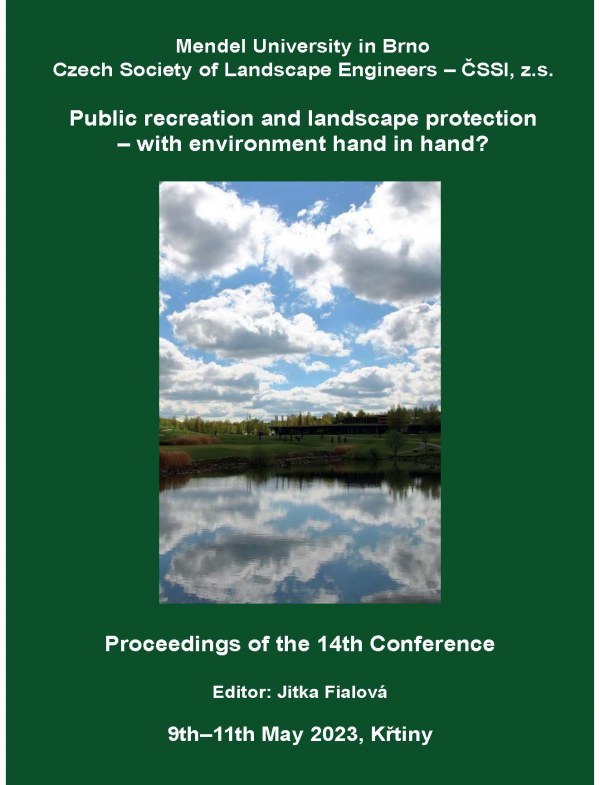
DOI: 10.11118/978-80-7509-904-4-0193
POSSIBILITIES AND ADVANTAGES OF INDIVIDUAL RECREATION IN THE TOPOĽČANY DISTRICT
- Regina Mišovičová, Zuzana Pucherová, Henrich Grežo
The individual form of recreation and spending free time individually came to the fore during the COVID-19 pandemic. In the area – the Topoľčany district, there are several alternatives for individual recreation, which are provided by natural ecosystems, cultural-historical, sacral and architectural monuments. In research connection with the aesthetics of the landscape, they provide several opportunities for recreational activities: hiking and cycling, camping, fishing, swimming, observing plants and animals, the ever-expanding use of agrotourism in a rural environment. Locations with such a focus are part of the Regional Territorial System of Ecological Stability – 21 biocenters, 27 biocorridors and 41 ecostabilization elements with total area 18,271.25 ha. In recent years, in connection with recreation, the concept of "ecotourism" has come to the fore as a sustainable form of recreation based on natural wealth, primarily focused on experiences and the study of nature. It is associated with minimal waste production and almost no consumption, protects the landscape, the environment and biodiversity, improves the prosperity of local people and should be economically viable, ecologically sensitive, and culturally appropriate. The main aim of the contribution is to point out the possibilities of individual recreation for residents in the Topoľčany district with the criterion of ecotourism.
Keywords: ecotourism, individual free time, landscape protection, recreational activities
pages: 193-197, Published: 2023, online: 2023
References
- Ceballos-Lascuráin, H. (1996). Tourism, Ecotourism and Protected Areas: The State of Nature-Based Tourism around the World and Guidelines for Its Development. IUCN Publications, Cambridge, 301 pp. DOI: http://dx.doi.org/10.2305/iucn.ch.1996.7.en
 Go to original source...
Go to original source... - Doubleday, A. et al. (2021). How did outdoor biking and walking change during COVID-19?: A case study of three U.S. cities. PLOS ONE, 16(1), e0245514. DOI: https://doi.org/10.1371/journal.pone.0245514.
 Go to original source...
Go to original source... - Kočický, D. et al. (2019). Regional territorial system of ecological stability for District of Topoľčany. Banská Štiavnica: ESPRIT, Ltd.; Nitra: CPU in Nitra FNS DEE, 259 s. Available at: https://download.sazp.sk/RUSES_II/
- Koščová, N., Koščová, M. (2013). Present state and possibilities of development of wildlife tourism in Slovakia. In: Acta Universitatis Prešoviensis, Folia Oecologica 10, Vol. LVII, p.75-92.
- Kurek, W. et al. 2007. Tourism. Warszawa: PWN. 540 pp.
- Matlovičová, K. et al. (2015). Tourism and its forms. Prešov: PU in Prešov. 550 pp.
- Ružička, M., Ružičková, H. 1973. Secondary Landscape Structure as criteria of biological equilibrium. Quaestiones Geobiologicae, 12, 23-62.
- Sayan, M. S., Atik, M. (2011). Recreation Carrying Capacity Estimates for Protected Areas: A Study of Termessos National Park. Ekoloji, 20(78), 66-74. DOI: https://doi.org/10.5053/ekoloji.2011.7811.
 Go to original source...
Go to original source... - Shin, W.S. et al. (2010). Forest experience and psychological health benefits: The state of the art and future prospect in Korea. Environ. Health Prev. Med, 15, 38-47.
 Go to original source...
Go to original source... - The concept of the development of natural tourism in the Banská Bystrica region until 2030. Processor: Aevis foundation. 2021, 68 pp. Available at: https://rabbsk.dobrykraj.sk/subory/koncepcia/Koncepcia_PCR_BB%20KRAJ_2021.pdf
- Zaręba, D. 2010. Ecotourism. 3rd edition. Warsaw: PWN.


